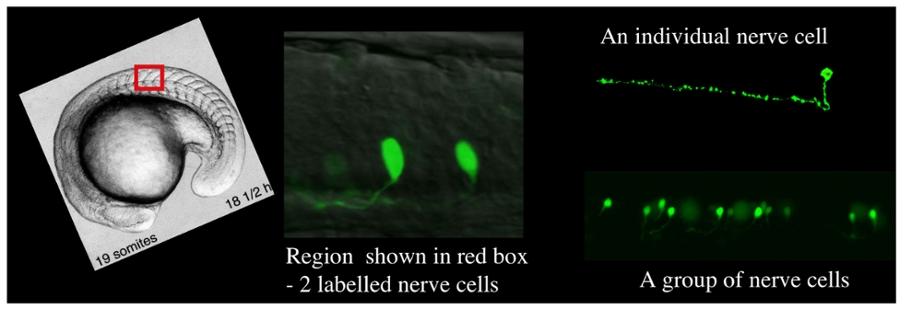Interneuron Development in the Zebrafish Spinal Cord
The vertebrate nervous system contains many different specialized neurons that form at distinct, characteristic positions and develop specific axonal connections and functions. Most of these neurons are interneurons, but we currently know very little about how different types of interneurons are specified. In recent years we have learnt an amazing amount about motoneuron specification in different vertebrates. The success of these studies suggests that we should be able to analyse interneuron development in a similar manner. This is exciting, as interneurons function in almost all neural circuits and behaviours and defects in specific interneurons have been implicated in a number of neurological disorders including schizophrenia, bipolar disorder and Creutzfeld-Jakob Disease.
We are using Genetics, Cell Biology and Developmental Biology to investigate how the correct number and pattern of interneurons forms in the vertebrate spinal cord, and how these interneurons acquire their specific characteristics and functions. The evidence so far suggests that the morphology and function of different neurons is determined, at least in part, by the specific regulatory genes that they express. Some genes are probably required for survival or specification of particular neurons, whereas other genes are required for specific aspects of neuronal morphology and function. We are therefore investigating which regulatory genes are expressed by specific interneurons and what the roles of these regulatory genes are in determining different neuronal characteristics.

We use zebrafish as a model system, as their relatively simple nervous system facilitates studies of neural circuitry and function and enables cell fate specification to be studied at the level of both single cells and populations of cells. Zebrafish are also a powerful system for combining genetic and embryological studies as their embryos are readily accessible and optically transparent, allowing us to easily follow the development of individual neurons and observe gene expression in live embryos; and mRNA over-expression methods, mutant lines and antisense oligonucleotide techniques allow us to quickly and easily examine the functions of different proteins in vivo. As most of the genes involved in spinal cord development are conserved between vertebrates, the insights that we gain about the functions of specific genes should be widely applicable.
The knowledge that we gain from this research will ultimately be important for developing treatments for nervous system diseases, disorders and tumors, as well as methods for facilitating the repair of particular nerves after injury or neurodegeneration. For example, understanding the roles of different genes in specifying particular neurons will enable researchers to grow specific types of neurons from stem cells for treating conditions such as Alzheimer’s disease, Parkinson’s disease, stroke and spinal cord injuries. In addition, understanding the genetic differences between neurons will help us to understand why neurodegenerative diseases often only affect specific classes of neurons.
Our long term goals are to determine not only how different neurons are specified, but also how specific neurons function in particular neural circuits and behaviours. This will enable us to connect how the nervous system develops with how it functions. Zebrafish are ideal for these studies as they are a genetically tractable vertebrate, in which it is possible to follow the development, and test the function, of different neurons in live embryos. For example, we can use transgenic GFP lines to identify specific neurons in live embryos, observe how neurons connect with each other, test the functions of these resulting circuits, and determine how these circuits or functions change when particular genes or neurons are lost. We can also examine existing zebrafish mutations that potentially affect neural development or behaviour, and conduct new mutational screens, to identify additional, and potentially novel, genes that affect neural development and function.
Useful links:
ZFIN (www.zfin.org) the zebrafish database
Quicktime Movie: timelapse movie of early zebrafish development (1.1MB)



